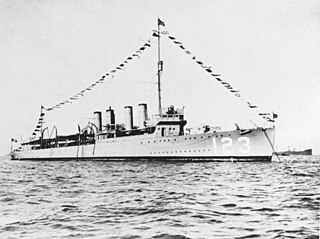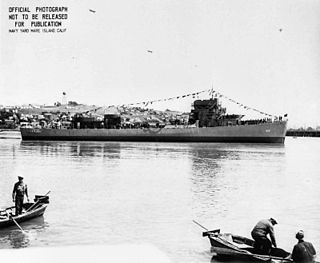
The Mahan-class destroyers of the United States Navy were a series of 18 destroyers of which the first 16 were laid down in 1934. The last two of the 18, Dunlap and Fanning, are sometimes considered a separate ship class. All 18 were commissioned in 1936 and 1937. Mahan was the lead ship, named for Rear Admiral Alfred Thayer Mahan, an influential historian and theorist on sea power.

USS Gamble (DD–123/DM-15) was a Wickes-class destroyer in the United States Navy during World War I, later converted to a minelayer in World War II.

USS Tracy (DD-214/DM-19) was a Clemson-class destroyer in the United States Navy during World War II. She was the only ship named for Secretary of the Navy Benjamin Franklin Tracy.

USS Patterson (DD-392), a Bagley-class destroyer, was the second ship of the United States Navy to be named for Daniel Todd Patterson, an officer of the US Navy who served in the Quasi-War with France, First Barbary War, and the War of 1812.

USS Downes (DD-375) was a Mahan-class destroyer in the United States Navy before and during World War II. She was the second ship named for John Downes, a US Navy officer.

USS Spangler (DE-696) was a Buckley-class destroyer escort of the United States Navy.

USS Zebra (AKN-5) was an Indus-class net cargo ship in the service of the United States Navy in World War II. The ship was originally the Matthew Lyon, an EC2-S-C1 Liberty ship, operated for the War Shipping Administration (WSA) as a cargo vessel by an agent until severely damaged by torpedo in August 1943. While at Espiritu Santo in the New Hebrides awaiting likely scrapping the Navy acquired the vessel under bareboat charter to be used as a net cargo ship transporting reclaimed anti-submarine netting.

USS Darby (DE-218) was a Buckley-class destroyer escort in service with the United States Navy from 1943 to 1947 and from 1950 to 1968. She was sunk as a target in 1970.

USS Deede (DE-263) was an Evarts-class destroyer escort in the United States Navy.

USS Halloran (DE-305) was a Evarts-class destroyer escort of the United States Navy.
USS Annoy (AM-84) was an Adroit-class minesweeper of the United States Navy. She was laid down on 3 December 1941 at Portland, Oregon, by the Commercial Iron Works; launched on 6 April 1942; and commissioned on 2 September 1942. In 1944 she was reclassified as a patrol craft and renamed PC-1588.

The second USS Fleming (DE-32), and first ship of the name to enter service, was an Evarts-class destroyer escort built for the United States Navy during World War II. While performing convoy and escort duty in the Pacific Ocean she was also able to sink one Japanese submarine and to shoot down several kamikaze planes that intended to crash onto her. For her military prowess under battle conditions, she was awarded four battle stars.

USS Sederstrom (DE-31) was a Evarts-class destroyer escort of the United States Navy during World War II. She was promptly sent to the Pacific Ocean to escort convoys and to protect other ships from Japanese planes and submarines. Her assignments took her from one battle area to another, but she was fortunate in remaining almost unscathed by the end of the war. For her efforts in battle areas, she was awarded five battle stars by war's end.

USS LeHardy (DE-20) was an Evarts-class destroyer escort constructed for the United States Navy during World War II. It was promptly sent off into the Pacific Ocean to protect convoys and other ships from Japanese submarines and fighter aircraft. At the end of the war, she had the honor of proceeding to Wake Island, as the Japanese commander surrendered, and raising a flagpole to fly the American flag once again.

USS Wintle (DE-25) was an Evarts-class destroyer escort constructed for the United States Navy during World War II. It was promptly sent off into the Pacific Ocean to protect convoys and other ships from Japanese submarines and fighter aircraft. By the end of the war, when she returned to the United States, she was awarded three battle stars.

USS Emery (DE-28) was an Evarts-class destroyer escort constructed for the United States Navy during World War II. It was promptly sent off into the Pacific Ocean to protect convoys and other ships from Japanese submarines and fighter aircraft. By the end of the war, she had accumulated three battle stars.

USS Dionne (DE-261) was an Evarts-class destroyer escort of the United States Navy during World War II. She was sent off into the Pacific Ocean to protect convoys and other ships from Japanese submarines and fighter aircraft. She performed escort and antisubmarine operations in dangerous battle areas and returned home with six battle stars, a high number for a ship of her type.

USS Lake (DE-301) was an Evarts-class destroyer escort of the United States Navy during World War II. She was sent off into the Pacific Ocean to protect convoys and other ships from Japanese submarines and fighter aircraft. She performed escort and antisubmarine operations in dangerous battle areas and returned home with two battle stars.
USS Connolly (DE-306) was an Evarts-class destroyer escort of the United States Navy during World War II. She was sent off into the Pacific Ocean to protect convoys and other ships from Japanese submarines and fighter aircraft. She performed escort and antisubmarine operations in dangerous battle areas and returned home with two battle stars.

USS Loeser was a Buckley-class destroyer escort of the United States Navy, named in honor of Lieutenant Commander Arthur E. Loeser (1903–1942).


















